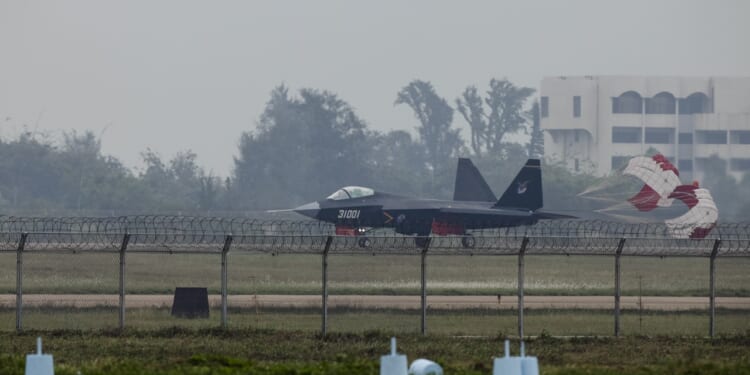Unless the United States is planning to drastically curtail its commitments around the world and upscale its presence in the Indo-Pacific, China will beat America purely with quantity.
Here’s a startling statistic: China is believed to possess more than 200 Chengdu J-20 “Mighty Dragon” fighter jets, with five production lines—and one new J-20 built every eight days.
By comparison, the US does not produce any new F-22 Raptors. It has around only 185 of those aircraft, with some of the oldest among them nearing retirement. The Americans possess more F-35 Lightning II warplanes; the Department of Defense has 400 airframes spread across the Air Force, Navy, and Marine Corps. But the F-35s cannot necessarily be relied on; as of this writing, they are thought to have only a 60 percent readiness rating. These are startling disparities—and should be top of mind for the Air Force’s defense planners.
What to Know About China’s Fifth-Gen Warplanes
| Aircraft | Chengdu J-20 Mighty Dragon | Shenyang J-35 |
| Year Introduced | 2017 | 2025 |
| Number Built | 300+ | Unknown; low tens |
| Length | 21.2 m (69 ft 7 in) | 17.3 m (56 ft 9 in) |
| Wingspan | 13 m (42 ft 8 in) | 11.5 m (37 ft 9 in) |
| Weight (MTOW) | 37,000 kg (81,571 lb) | 28,000 kg (61,729 lb) |
| Engines | Two Shenyang WS-10C afterburning turbofan (~32,000 lbf with afterburner) | Two Guizhou WS-21 afterburning turbofan engines |
| Top Speed | Mach 2.0 (1,320 mph, 2,130 km/h) at altitude | Mach 1.8 (1,330 mph, 2,200 km/h) at altitude |
| Combat Radius | 2,000 km (1,200 mi) | ~1,250 km (~780 mi) combat radius |
| Service Ceiling | 20,000 m (66,000 ft) | 16,000 m (~52,000 ft) |
| Loadout | Eight hardpoints (internal and external); 11,000 kg (24,000) total payload capacity | 12 hardpoints (6 internal, 6 external); 8,000 kg (18,000 lb) total payload capacity |
| Aircrew | 1 | 1 |
Like the United States, China fields two fifth-generation warplanes. Its Chengdu J-20 is an air superiority fighter, meant to rival the US-made F-22 Raptor. It has also designed a multirole fifth-generation fighter, the Shenyang J-35, in answer to the US-made F-35 Lightning II. Both the F-35 and the J-35 have both a land-based variant and a carrier-based variant.
China currently possesses only a handful of J-35s, but it is reportedly standing up the production line. Open-source information suggests that China intends to produce around 50 airframes per year, or slightly less than one per week. Pakistan, a close Chinese ally, has also expressed interest in buying an export variant of the J-35, helping to fast-track the production line.
In other words, the Americans have the numerical advantage when it comes to F-35s—but that is not really the issue. This is particularly so when one considers that China is already flying an alleged sixth-generation warplane, and is marrying advanced “loyal wingmen” drones with their existing fifth-generation planes.
What’s more, the staggering rate at which Beijing is mass producing the J-20s alone at such a clip that they will outpace the F-35 fleet in two to three years. For comparison, the Americans are only producing 140 F-35s a year, despite having a 20-year lead.
When fused with advanced drones and China’s comprehensive anti-access/area-denial (A2/AD) capabilities, the ability for the United States to project power into contested areas near China’s shores has become far more complicated than they should be.
Of course, US warplanes are more advanced in some ways, and have far greater combat experience than their Chinese rivals do. But that’s hardly enough these days. Any potential conflict between the United States and China would be over territory, such as Taiwan or the South China Sea, nearer to Chinese shores—that fall well within China’s A2/AD bubbles and the range of their numerically superior warplanes.
China Already Has a Crucial Numerical Advantage
And China has one major advantage over the United States when it comes to numbers. America has commitments all over the world—spanning the breadth of Asia, but also Europe and the Middle East. By contrast, China has one objective, and one objective only: the First Island Chain. So, even though America technically possesses a larger fleet of F-35s and F-22s, those planes are scattered across the world—and would not be available in the event of a clash with Beijing. By contrast, China would have their warplanes arrayed fully against US forces in the Indo-Pacific, as it has been planning for years.
In other words, unless the United States is planning to drastically curtail its commitments around the world and upscale its presence in the Indo-Pacific, China will beat America purely with quantity. Whatever superior quality US warplanes may possess, the fact is that quantity has its own quality. And there is simply no way that the US defense industrial base can catch up to what China is doing in terms of warplane-for-warplane production.
What is to be done? The only obvious answer—besides the far larger challenge of reforming America’s elephantine defense industrial base—is for the Pentagon to focus its attention on building swarms of unmanned aerial vehicles (UAVs) and hypersonic weapons to offset the numerical advantages that Chinese warplanes today enjoy over their American rivals.
About the Author: Brandon J. Weichert
Brandon J. Weichert is a senior national security editor at The National Interest. Recently, Weichert became the host of The National Security Hour on America Outloud News and iHeartRadio, where he discusses national security policy every Wednesday at 8pm Eastern. He is also a contributor at Popular Mechanics and has consulted regularly with various government institutions and private organizations on geopolitical issues. Weichert’s writings have appeared in multiple publications, including The Washington Times, National Review, The American Spectator, MSN, The Asia Times, and others. His books include Winning Space: How America Remains a Superpower, Biohacked: China’s Race to Control Life, and The Shadow War: Iran’s Quest for Supremacy. His newest book, A Disaster of Our Own Making: How the West Lost Ukraine is available for purchase wherever books are sold. He can be followed via Twitter @WeTheBrandon.
Image: Shutterstock.


















